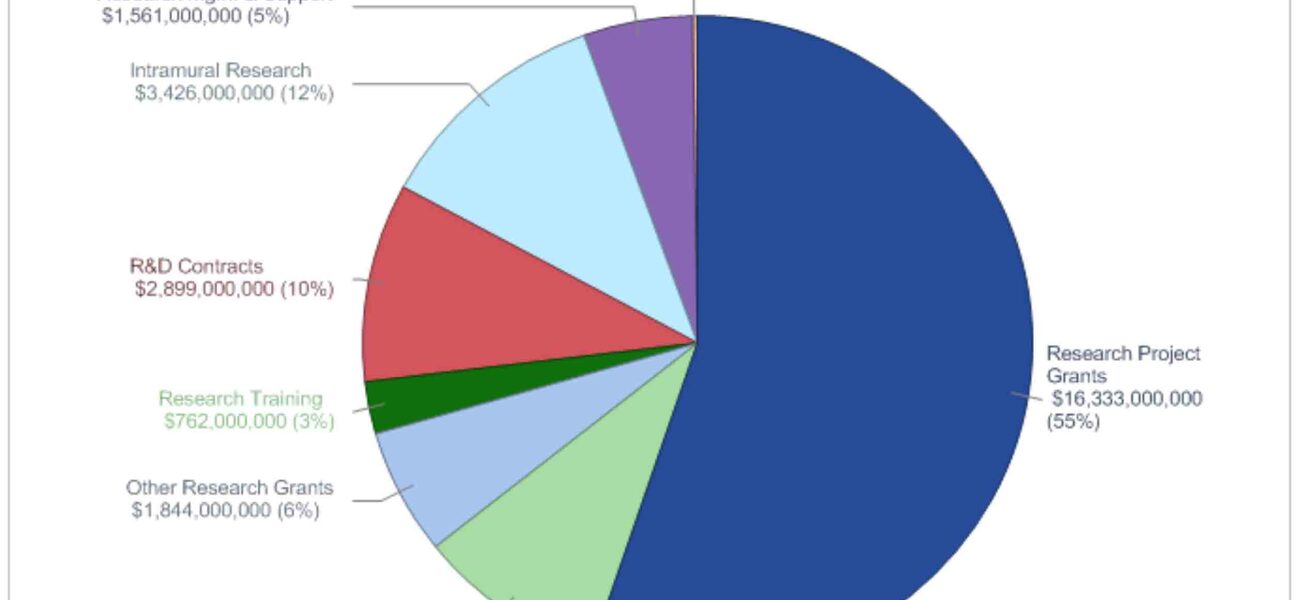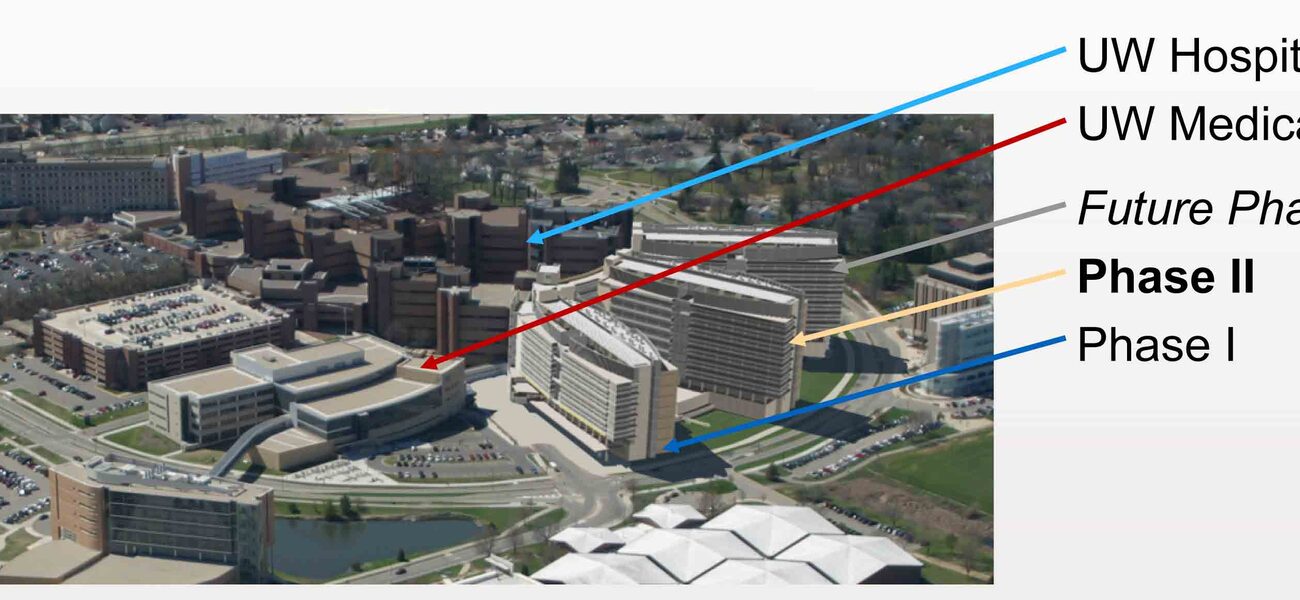A backlog of construction, renovations, and upgrades may finally come to life, thanks to the $2 billion increase in NIH funding Congress approved in December, the first increase in more than 12 years. More than 80 percent of the $32 billion NIH budget is dedicated to extramural research—research outside the NIH itself—meaning that an additional $1.6 billion in research grants will be made available this year.
“A lot of places are sitting on projects,” says Mark C. Wells, AIA, assistant dean for facilities at the University of Wisconsin School of Medicine and Public Health, which ranks among the top 25 institutions when it comes to securing NIH grants. “Research funding directly impacts everything we do. We’re not going to build new buildings if we can’t justify it from the amount of grant money coming in.”
Research institutions build for the science they want to pursue and the researchers they want to attract, not for the grants they hope to win. But when the funding becomes available, they need to be prepared.
“When grants are submitted, we generally will be asked to state whether we have the facilities to perform that grant,” says Erik Halle, director of research facilities and infrastructure at Arizona State University. “To the extent that we can have facilities that are ready, that helps. Research grants are contractual deliverables, on a schedule. We try to have the facilities available, but it’s a delicate balancing act; we don’t want to sit on empty facilities.”
“NIH is very astute in recognizing that,” adds Niraj Dangoria, associate dean for facilities management at the Stanford School of Medicine. “They have equipment grants that are separate from research. There is time between grant notification and grant reward; often times there is a lot more infrastructure needed—people, equipment, space—to satisfy a grant requirement.”
The boost in NIH research funding could spur facilities development in several ways. Institutions that grow their research may find that they need more space, or they need to upgrade the space they have, in order to accommodate new or expanded lines of research, or to bring their labs up to NIH standards. In addition to the money NIH itself offers for construction, renovation, and equipment in the form of C06 and G20 grants, securing NIH research funding can help an institution raise external money for facilities projects.
“If you can go to a potential donor and show them the science and the impact those dollars have on real people, that’s what will convince most donors,” says Eric W. Boberg, executive director for research at Northwestern University’s Feinberg School of Medicine. “Research dollars generate interesting science; interesting science generates an impact on the community, which generates more dollars. There’s a positive feedback loop there.”
Christopher Czura, vice president of scientific affairs at the Feinstein Institute for Medical Research, agrees. “NIH grants are considered honorific. They are an endorsement of your research and a boost to an investigator’s career. Any investment already in that research program validates it and makes other sponsors and investors more interested.”
Planning for Growth
Many institutions have been in a growth pattern, despite essentially flat NIH budgets over the past decade.
“The hope is that you build some capacity to sustain yourself through these cycles,” says Dangoria.
The Feinberg School at Northwestern, for example, broke ground last year on a 600,000-sf lab building, which is scheduled for completion in late 2018. “Between now and then, we’re making the most efficient use possible of our current space,” says Boberg.
Arizona State University doubled its research expenditures in the past 10 years, from $200 million to $400 million, and is on a path to spending $700 million a year by 2020. Over the past 14 years, ASU has built six new research buildings, adding about 1 million gsf to its portfolio. They are currently designing a new 200,000-sf interdisciplinary research building scheduled to open by early 2018.
“We’re at a point right now that we’ll be constructing a new facility because we’re out of space,” says Halle. “We might accelerate our rate of growth if we were to be very successful with additional NIH funding.
“We are filling our buildings and continuing to build,” he says. “We will need to build more over the next several years.”
Stanford University also has been expanding its research facilities portfolio … and filling it.
“A lot of our peers have felt that they have too much space,” says Dangoria. “For us, if we get our fair share of the funding, we will need to expand our capacity.”
The University of Wisconsin has spent the past 15 years investing in new facilities and upgrading aging ones. But as the federal research funding dropped off, those spaces were not fully utilized.
“I’ve got a $200 million tower we have in our plan, but rather than doing that, we’re doing a $20 million research facility expansion,” says Wells.
The expanded NIH funding does not change that plan in the short term, but continued support for research puts long-term projects like the tower back on the table.
“We’re not going to go build our $200 million tower right now,” says Wells. “We will compress into the space we have available and, depending on what the numbers look like in the first year—the number and size of grants awarded—then I’m sure we’d start talking about facilities. Here we are sitting on modern facilities that have more potential. With more research dollars available, we’ll pack them in. In the next five years, we’ll be short of facilities again. We’ll be looking at the new tower in the next 10 years, and if there is a dramatic change in funding, my prediction is we’ll start looking for a quicker turnaround than 10 years.”
The University of Chicago finds itself in a similar position. “There is a pent-up amount of space that we would have the ability to occupy with additional grant funding,” says Scott DeBlaze, director of space planning and real estate management at the University of Chicago Medicine and Bioscience Division and the Pritzker School of Medicine. “There is an amount of inventory to fill.”
The Feinstein Institute for Medical Research in New York recently completed a strategic plan that first calls for more efficient utilization of existing space, and then, within the next three to seven years, construction of a new research facility dedicated to bioelectronic medicine. Bioelectronic medicine is a specific field of bioengineering that involves developing electronic devices that can interact with and modulate neural pathways.
“We’re specifically looking at introducing more technology into medicine,” says Czura. “We need to build engineering capability, which requires a very different kind of laboratory. The second angle is to recruit those engineers who understand how to interact with nerves.”
“The reality is that we have not built our strategic plan based on what’s happened at the NIH,” says Czura. “But the NIH is a good colleague to have. Additional funding would move up the construction. Right now, we want to plan slowly—there’s no sense doing it without the dollars in place. Once we have the dollars, we can mobilize an army.”
Targeted Research
Some of the NIH budget is earmarked for specific programs that rely on computational labs and imaging cores, as well as traditional wet bench research:
- $200 million to support President Obama’s Precision Medicine Initiative, including $130 million for the Precision Medicine Initiative Cohort Program, and $70 million for the Precision Medicine Oncology project. The Precision Medicine Oncology project will include new studies of how the DNA from an individual tumor can be used to predict the right choice of targeted therapies, how resistance to therapy can occur, how to apply new non-invasive methods to track response to therapy, and how to begin to test new combinations of targeted cancer drugs. The Cohort Program will enroll 1 million or more individuals who agree to share their electronic health records and other data, including genomic information. The database will lay the foundation for a wealth of new research studies.
- An additional $85 million for the BRAIN (Brain Research through Advancing Innovative Neurotechnologies) Initiative, bringing the FY16 investment to $150 million, which will accelerate the development and application of next-generation tools to construct dynamic pictures of the brain, revealing how millions of brain cells and complex neural circuits interact in real time.
- An additional $100 million for antimicrobial resistance research, in support of the Administration’s National Strategy for Combating Antibiotic-Resistant Bacteria.
Many institutions find themselves positioned for just this kind of research. In fact the Stanford School of Medicine recently established a new department dedicated specifically to biodata sciences.
“For us, this is fantastic news,” says Dangoria. “Our new master plan is based precisely on having clinicians and researchers and data-based faculty. It aligns perfectly with the sort of things that are in the bill.”
The University of Chicago is also building big data capacity for genomics research.
“We’ve been making substantive investments in server farms and infrastructure to provide for the ability to crunch data,” says DeBlaze. “The investment there, in certain cases, rivals the investment in wet-lab research.”
Opening Research to a New Generation
A growing concern in scientific research is the lack of funding available for young, innovative investigators.
“One of the most telling statistics is that researchers are well into their 40s before they get their first NIH grant,” says Dangoria. “When you have a smaller pool of money, you want to bet on the most success possible. With more money to spread out, you’re willing to take more of a chance. That’s when you’re going to see the younger faculty winning the grants, and that’s what we want to see.”
Funding younger researchers is particularly critical as the fields of technology and medicine continue to merge.
“We are trying to integrate technology more and more as a solution for medicine,” says Czura. “Technology is driven by the young people; it is that cadre of young researchers who will drive the field forward. We are shortchanging them and the country and the world by underfunding them.”
This additional funding has been approved for only one year, but the thought is that the NIH will continue to renew its budget at least at the $32 billion level.
“I can’t imagine that the additional $2 billion will not be renewed,” says Czura. “It would be a slap in face, an aggressive assault on research, not to renew it.”
“There’s no doubt that when the research increases, the facilities will, too,” concludes Wells.
By Lisa Wesel


